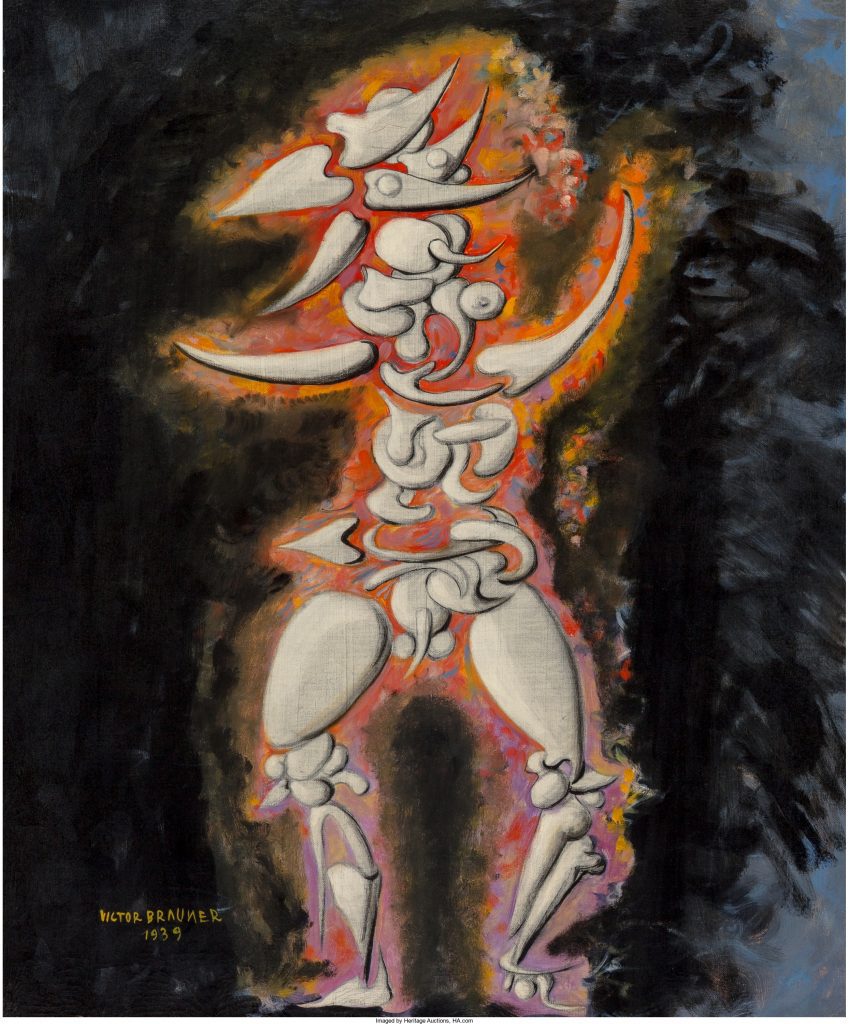Victor Brauner (1903-1966)
Denombrement III, 1938-1939
Oil on canvas
Courtesy of the Leonid and Tatiana Nevzlin Collection
The Romanian Surrealist painter Victor Brauner was a member of the French avant-garde. he is best known for his interest in alchemy, lore and the esoteric, and for incorporating religious and mythical signs and symbols into his work. Denombrement III conveys a sense of loss and fragmentation captured, among other things, by the artist’s depersonalization of the human form.
Must Know
Born in Romania, Victor Brauner knew at first hand the artistic ferment of 1920s Bucharest and the avant-gardes – Expressionism, Constructivism, Dada – whose radicalism so closely matched his independent spirit. From 1925 onwards regular stays in Paris, where he would settle definitively in 1938, saw his painting gradually shift towards Surrealism. By 1933 he had joined the movement and continued to take part in its activities until his exclusion by André Breton in 1948.
The loss of an eye in 1938 made his Self-portrait of seven years earlier a premonitory illustration of Surrealism’s theories and his painting a form of magic. Unable to migrate to the United States when war broke out, he had no choice – as a Jew, an undocumented foreigner and an opponent of all forms of fascist and totalitarian oppression – but to go underground in the South of France, where he sought to ward off constant danger via the esoteric doctrines of the tarot, alchemy, spiritism and the kabbala. In this dream world where reality no longer held sway, his work took on a mystery all its own. Paradoxically this time of fear and utter destitution was also one of great technical inventiveness, typified by his resort to wax and salvaged materials, and formal innovation.
. His practice, which included painting, drawing, and printmaking, drew from disparate symbolic systems like Tarot Cards, Egyptian hieroglyphics, and ancient Mexican codices. Brauner asserted that all of his paintings were autobiographical in some way. In this sense, the fantastic animals, such as the dragons, may be interpreted as symbolic representations of his deep-down, personal fears.
he led a turbulent life of constant displacement; anticipating the danger of World War II, Brauner reduced the dimensions of his canvases such that each could fit in his luggage for emergency travel—he called these his “suitcase paintings.”
A prolific inventor who participated actively in the Surrealist movement. Victor Brauner was not only a painter but also created a number of other forms of art; assemblages, sculptures, posters and illustrations. By inscribing the visual world of dreams, trances, prophetic experiences and South American Folklore, Brauner attempted to discover a meaning of the world defined through myth, executed through eclecticism, and his Surrealist art. Brauner’s paintings not only defy the laws of imagination exorcized through exotic Romanian spirituality and surreal poetry, but are also noteworthy for their artistic investigation, art historical and scholastic merit.
This work entitled “enumeration” in english seems to list all the different body parts that we see through the flayed skin. This creature resembles Mexican codex illustrations and suggests something ancient.
The body is depicted as fragmented, artificial and mechanical. Each evoking a strange mechanism, an articulation of an imaginary anatomical drawing symbolizing Brauner’s traumatic and repressed anxieties. The mixture of parts thus pertains to the myth of the archaic arts.

